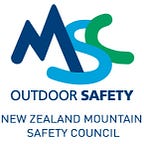BLOG: When is a jacket not a jacket?
Mike Daisley, CEO Mountain Safety Council
We spend a fair amount of time at MSC trying to work out how to better prepare people heading into our incredible backcountry regions. Often, we’re left a little bemused that some people don’t take a common-sense approach to their trips, and in particular, the equipment they take or don’t take as the case may be.
I wrote an article in March ‘Why you should always take a jacket’ which has been one of the most widely read to date. Where that article focuses on why you should take one (you should) this article explores the misconceptions people may have about what’s sufficient for Kiwi conditions, in particular the humble jacket.
So, what is a jacket, and what do I mean by ‘sufficient for Kiwi conditions’. The image above of the lush, wet forest is a good example of sub-alpine Kiwi terrain, beech forest in this case. It doesn’t even need to be raining in NZ to make you wet! Anyone who’s pushed through this sort of forest will tell you they were soaked in minutes. So what sort of barrier do you need, and why is it so important?
You need a waterproof and ideally breathable outer or ‘shell’ layer to effectively deal with rain, snow and wind (more on this soon). There’s plenty of inexpensive waterproof jackets that are mostly PVC coated fabrics. These are good at keeping water out, but critically they don’t let your moisture — as sweat — back out. They aren’t ideal as you end up wet from sweat anyway. Prices for a breathable shells layer are much cheaper than they once were and should be considered part of the core essentials of any tramping trip. If you can’t stay dry, you’ll be cold very quickly.
How cold? Well, on average you’ll lose, around 2 C° for every 10 kmh of wind. So, in 50 kmh wind you’ll need to account for 10 C° of heat loss. A windproof layer will significantly reduce the effective wind chill, and is therefore a must for every trip, even in summer. If you are wet, the wind chill effect can be amplified; if you’ve ever got out of a shower and walked (shivered) to a cold room you’ll know what this is like! Add to this a 7 C° drop in atmospheric temperature for every 1000m you ascend and you’ll quickly be in single or minus digits compared to sea-level temperatures. Staying out of the wind is crucial.
Putting all of this together you can see that a ‘waterproof, breathable, windproof’ shell jacket (and pants if you can afford it) gives you the best chance at keeping your insulation layers — fleece, wool, merino, down — dry and therefore warm. Cutting the wind-chill is especially important in exposed areas like ridgelines or above the tree-line.
Sadly, ignoring or not understanding the importance of this crucial piece of equipment greatly contributed to the deaths of two tramper in the Tararua’s. Had they had waterproof and breathable shell jackets — not the thin non-waterproof non-windproof urban jackets they went with — their ability to deal with the elements on the day would have significantly improved. Would it have saved them? Possibly, yes, but it’s impossible to be sure. In survival situations like this, even small improvements in how your body is functioning can have big positive effects on your ability to respond effectively.
In the recent Stuff article coroner Tim Scott said “they were reasonably well-equipped, taking plenty of food and sleeping bags.”
However, there were some “significant” absences from their kit, he said.
They had no survival blankets, waterproof covers for the sleeping bags, or a means of communication, apart from a cellphone.
They had no maps, compass, torch or emergency locator beacon, and no wet-weather gear to keep their heads and torsos warm and dry.
The jackets they did have were described by a police officer as “the kind that one might use in wet weather for a half-hour shopping trip”, Scott said
I sincerely hope you’re never in a tricky survival situation like this one. But, it can and does happen, even to experienced trampers every year. Most of these situations are effectively dealt with and don’t show up in the incident statistics — our latest publication ‘A Walk In The Park?’ gives a window into the latest incident data. So, give yourself the best chance at a positive experience that you and your group make it home from. Take an appropriate jacket every time and insist that your group members do as well.
Mike Daisley
Chief Executive Officer, Mountain Safety Council
Further reading on planning and equipment,
> Central North Island: Why you should always take a jacket.
> Winter planning tips: Stay warm
> Don’t be an egg, take a jacket
Ready to plan your trip?
Learn More
We’ve got a whole range of resources and tools to get you up to speed for your adventures. Have fun out there!
